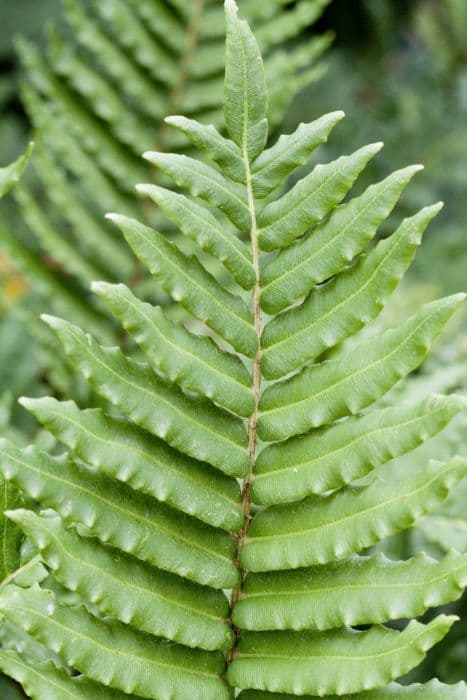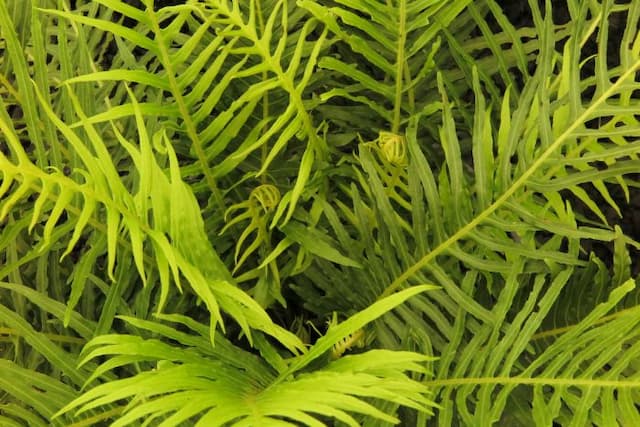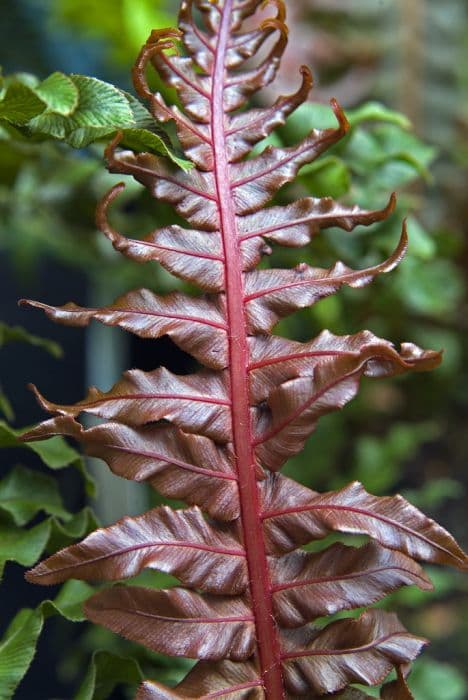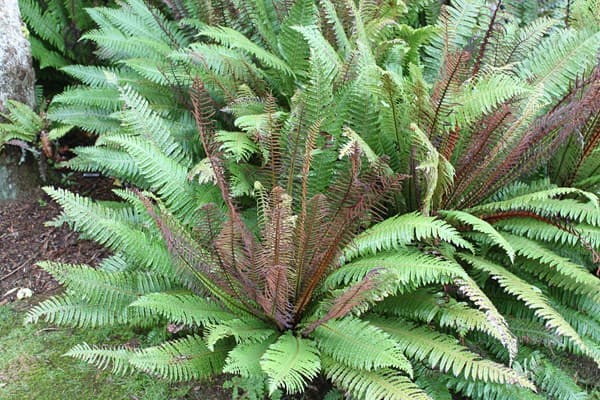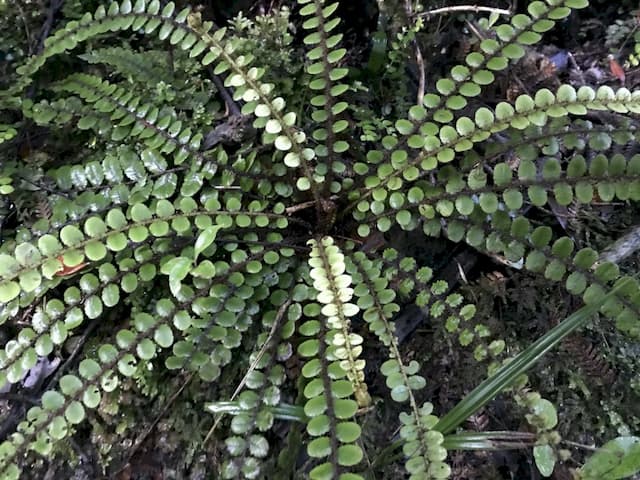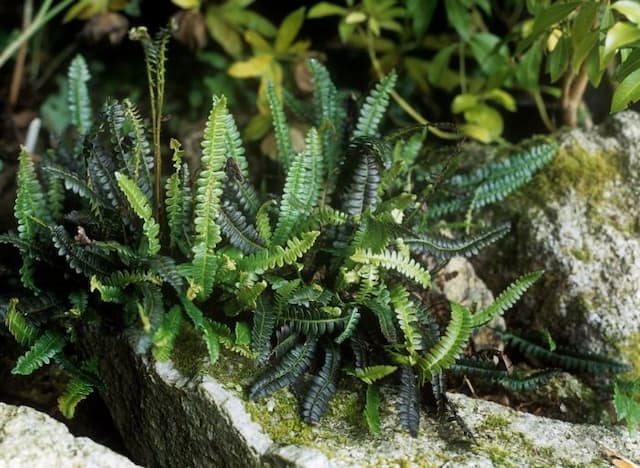Rasp Fern Doodia media

ABOUT
The plant known commonly as Rasp Fern is a visually striking fern with fronds that display a range of hues, from vibrant reds to greens. The young fronds are particularly noteworthy for their reddish-pink tones when they're emerging and unfurling. As the fronds mature, they shift color, becoming a deep green. These fronds are elongated and have a textured appearance due to the small, tooth-like edges along their margins. The overall look of the Rasp Fern is one of both delicacy and ruggedness, a mirror of its natural woodland habitats where it thrives, typically in the understory of forests where dappled sunlight filters through. The texture of the fronds invites touch, reminiscent of rough, fine-grade sandpaper, which is where its common name is derived from. This tactile quality is a defensive feature, deterring herbivores from feasting on the fern. The rich green of the mature fronds makes it an appealing plant for shaded garden areas where its color and texture can create an interesting visual contrast with other plants.
About this plant
 Names
NamesFamily
Blechnaceae
Synonyms
Razorback Fern, Small Rasp Fern, Prickly Rasp Fern, Common Rasp Fern
Common names
Doodia media var. aspera, Doodia media var. media, Doodia aspera, Doodia blechnoides, Doodia dives, Doodia lunata, Doodia media var. dives, Doodia media var. dura.
 Toxicity
ToxicityTo humans
Doodia media, commonly known as Rasp Fern, is not known to be toxic to humans. Therefore, ingestion of this plant should not cause poisoning or adverse symptoms.
To pets
Rasp Fern, the common name for Doodia media, is also not recognized as a toxic plant to pets. As with humans, ingestion by pets is unlikely to result in poisoning or harmful effects.
 Characteristics
CharacteristicsLife cycle
Perennials
Foliage type
Evergreen
Color of leaves
Green
Height
2 feet (0.6 meters)
Spread
2 feet (0.6 meters)
Plant type
Fern
Hardiness zones
9
Native area
Australia
Benefits
 General Benefits
General Benefits- Ornamental value: Doodia media, commonly known as Raspberry Fern, is appreciated for its attractive foliage and can serve as a decorative element in gardens and homes.
- Habitat enrichment: It contributes to the diversity of plant life within its natural habitat, offering shelter and food for native fauna.
- Soil stabilization: Raspberry Ferns can help prevent soil erosion in gardens and natural landscapes due to their root structure.
- Shade tolerance: This plant is capable of thriving in low-light conditions, making it suitable for shaded gardens.
- Drought resistance: Once established, Doodia media can tolerate periods of dryness, thus requiring less maintenance in terms of watering.
- Culinary use: Although this list excludes medical benefits, the young fronds of some fern species, including relatives of Doodia media, are sometimes used as a green vegetable.
 Medical Properties
Medical Properties- This plant is not used for medical purposes.
 Air-purifying Qualities
Air-purifying QualitiesThis plant is not specifically known for air purifying qualities.
 Other Uses
Other Uses- Doodia media, commonly known as Rasp Fern, can be used as a natural red dye due to the reddish color of its new fronds.
- The fibrous roots of the Rasp Fern may be woven into mats and traditional artifacts by Indigenous cultures.
- In garden design, Rasp Fern can be used as a ground cover, providing a lush green carpet in shaded areas.
- Due to its texture, Rasp Fern may be used in sensory gardens for educational purposes to exemplify the variety of plant textures.
- Rasp Fern can serve as a habitat plant, offering shelter and nourishment to various insects and microfauna.
- The contrast between the reddish-pink young fronds and green mature fronds of the Rasp Fern can be used artistically in floral arrangements.
- Dried fronds of the Rasp Fern might be utilized in craft projects, such as natural wreaths or as a component in mixed-media art.
- The Rasp Fern can be employed in terrariums or bottle gardens due to its compact size and preference for humid conditions.
- Some cultures might use the sturdy fronds of the Rasp Fern as natural bookmarks or as part of ceremonial offerings.
- As an educational tool, the Rasp Fern can help demonstrate the life cycle of ferns from spore to sporophyte in school science projects.
Interesting Facts
 Feng Shui
Feng ShuiThe plant Doodia media, commonly known as rasp fern, is not used in Feng Shui practice.
 Zodiac Sign Compitability
Zodiac Sign CompitabilityThe rasp fern is not used in astrology practice.
 Plant Symbolism
Plant Symbolism- Resilience - Doodia media, commonly known as Rasp Fern, has a remarkable ability to thrive in difficult conditions, symbolizing the capacity to endure and overcome challenges.
- Protection - With its tough, raspy fronds, Rasp Fern is often thought to represent shielding or guarding against hardship, much like it protects itself in nature.
- Healing - Some cultures may view the Rasp Fern as a plant with healing properties, potentially symbolizing restoration and health.
- Growth - The way Rasp Fern grows, often in inhospitable environments, can signify personal growth or development, especially through adversity.
 Water
WaterThe Raspberry Fern, also known as Doodia media, prefers consistent moisture but dislikes waterlogged soil. It should be watered thoroughly when the top inch of soil feels dry to the touch. Typically, this might be once or twice a week depending on the humidity and temperature conditions of the environment. When watering, use enough water to soak the soil all the way to the root zone, which may be approximately one to two gallons for a medium-sized plant, depending on pot size and soil composition. During the winter months, reduce watering slightly as the plant's growth slows.
 Light
LightThe Raspberry Fern thrives best in partial shade where it can receive dappled sunlight. An ideal spot would be one that mimics its natural understory habitat, such as the bright shade under a tree canopy or on a north-facing windowsill where it is shielded from the direct harsh rays of the sun.
 Temperature
TemperatureRaspberry Ferns are comfortable in a temperature range between 50°F and 75°F, which is typical for most indoor environments. However, they can tolerate a brief dip to 40°F and highs up to around 80°F; anything outside of this range could harm the plant. The ideal conditions for these ferns are cool to moderate temperatures that remain fairly consistent.
 Pruning
PruningPruning Raspberry Ferns is generally done to remove any brown or dead fronds to maintain the plant's aesthetic and health. Light pruning can be done anytime throughout the year as needed. The best time for more extensive pruning is in the spring before the plant enters its active growth phase, which allows the fern to rejuvenate with fresh new growth.
 Cleaning
CleaningAs needed
 Soil
SoilThe best soil mix for the soft tree fern should be rich, well-draining, and slightly acidic with a pH between 5.5 and 6.5. A mixture of two parts peat or coir, one part perlite, and one part compost or loamy garden soil works well.
 Repotting
RepottingSoft tree ferns should be repotted every 2 to 3 years to refresh the soil and accommodate root growth. Spring or early summer is the best time for repotting to allow the plant to establish before winter.
 Humidity & Misting
Humidity & MistingSoft tree ferns prefer high humidity levels, typically between 60% to 80%. They thrive in moist environments but need good air circulation to prevent fungal diseases.
 Suitable locations
Suitable locationsIndoor
Place soft tree fern in bright, indirect light with high humidity.
Outdoor
Grow soft tree fern in dappled shade, moist soil, shelter from winds.
Hardiness zone
9-11 USDA.
 Life cycle
Life cycleThe life of Doodia media, commonly known as Rasp Fern, begins with the dispersal of its spores, typically by wind. These spores germinate to produce small, heart-shaped gametophytes that contain both male and female reproductive organs. When conditions are favorable, sperm from the antheridia swim to the archegonia and fertilize the eggs, leading to the development of a new sporophyte—the familiar fern plant. The young sporophyte starts as an epiphyte on the gametophyte, eventually growing roots and leaves as it matures into an independent plant. The mature Rasp Fern has fronds that are bright green, often with a raspberry red tinge, and it reproduces asexually by producing spores on the undersides of the fronds. These spores are housed in structures called sori, which release them to start the cycle over again.
 Propogation
PropogationPropogation time
Spring-summer
The most popular method of propagation for the Rasp Fern (Doodia media) is through spore collection and sowing. In their natural habitat, Rasp Ferns typically release spores during the summer, which is generally the best time to collect them for propagation purposes. To propagate by spores, one must first collect the spores from the undersides of mature fronds when they are ripe and dust-like. These can then be sown on the surface of a well-drained, sterile potting mix kept under high humidity and indirect light. It's essential to maintain consistent moisture without making the medium waterlogged as the spores germinate and develop into new fern plants, which can take several weeks to months depending on environmental conditions. Careful handling and attention to the microclimate will help ensure successful germination and growth of the new Rasp Ferns.
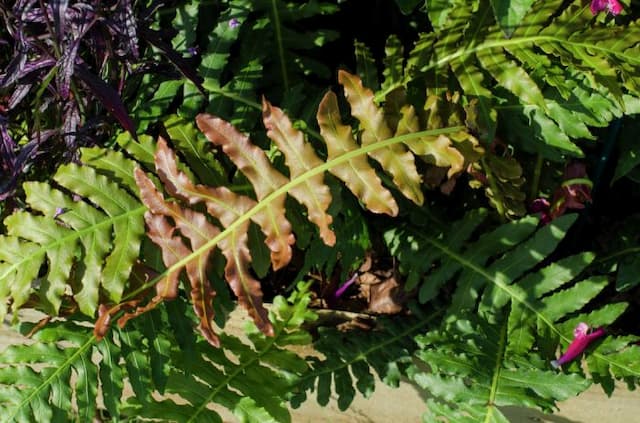
![Dwarf Brazilian tree fern [Eruption]](/_next/image?url=https%3A%2F%2Fplants-admin.emdemapps.com%2Fimages%2Fplants%2F%2Fimages%2F604b5592bbce2.png&w=640&q=75)
